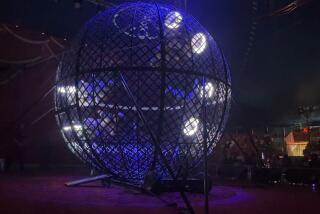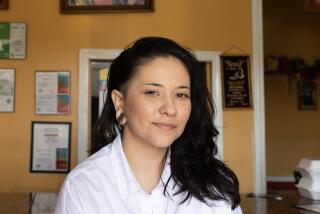Church of the Masses: 10,000 Call It Home
On a recent Saturday at Santa Rosa Catholic Church in San Fernando, the crowds began arriving at 8 a.m. for the first of five weddings. While the first bride laid her bouquet at a shrine to the Virgin of Guadalupe inside, the next waited with her attendants, all carefully packed into a long line of air-conditioned automobiles parked outside.
And then the babies started coming.
They arrived, 35 of them, dressed in satin and lace baptismal gowns--each pinned with a shiny gold Miraculous Heart of Mary medal. Mothers pushed their way past bridal dresses as a dozen video cameras began to whir and blink.
The church once baptized up to 65 babies en masse each Saturday. “Now we limit them to 35,” said Father David Ullrich, head pastor at Santa Rosa. “It was pandemonium. Even with 35 babies crying at once, it gets a little much.”
Santa Rosa attracts about 10,000 people every week--for baptisms, weddings, Masses and a variety of community-oriented services. But despite the crowds--large, by most church standards--parishioners, most of whom are first-generation Hispanics, say they are attracted by an unusual sense of family and culture.
‘Feels Like Home’
“Our tradition has been that we get together on Sunday and that’s the reason Santa Rosa is so popular among Hispanic people,” parishioner Salvador Ponce said. “They find a warm place that feels like home. They feel like they’re coming to a big family.”
“Santa Rosa has an ambiance,” said Sister Carmel Somers, who has worked with Ullrich as part of her job training leaders with the Industrial Area Foundation, an ecumenical organization based in New York. “The one thing that Santa Rosa provides in the Valley is a center that people can connect with. People are safe in that and it provides familiarity.”
Santa Rosa has served parishioners in the San Fernando Valley since 1925, when it began as a side chapel off St. Ferdinand’s, six blocks from the present church. Four other Spanish-speaking priests assist Ullrich and help oversee the adjoining Catholic school. The priests belong to Oblates of Mary Immaculate, an order numbering 6,000 worldwide that was founded in 19th-Century France to serve minorities.
The church, which seats 800, packs in about “6,000 on a slow Sunday” for its nine Masses, Ullrich said; seven are conducted in Spanish. Only one other church in the San Fernando Valley, Mary Immaculate in Pacoima, serves Hispanics on the scale of Santa Rosa.
Help With Earthly Concerns
Children wander about the sanctuary, traveling from father to uncle to grandmother to cousin just before the processional. Parishioners stand and kneel in the aisles, the back vestibule, doorways and outside where they can buy tamales, one dozen for $9.60, at a “Santa Rosa School Tamale Sale.”
Ullrich, 46, jokes--”Please close the door over there, or everyone will try to leave”--and chats informally with the congregation in Spanish, often announcing birthdays and asking questions.
Santa Rosa also assists members with more earthly concerns: Church officials help with income tax preparation, and there is a credit union for members. Through the government’s amnesty program that ended in May, church volunteers signed up 12,000 illegal aliens who now possess temporary green cards.
According to Ponce, Santa Rosa School, which adjoins the church, is a rallying point for the surrounding community. San Fernando is 70% Hispanic, according to the city clerk’s office.
“I like the education,” said Ponce, who married his wife Celia at Santa Rosa, had four children baptized in the same church and sent them to the adjoining school. “They encourage the kids to be close to the principles of the family.”
Ponce, 50, said he took greater interest in his church after drug trafficking escalated on his street, just one block from the church and school, two years ago.
“The problem was so bad they used to sell drugs in front of our house,” he said. “One afternoon I got really upset after my little girl asked me what I would do.”
Ponce joined one of 37 “outreach” groups the church has established, which help identify problems in other parts of the Valley and the surrounding 2.5 square miles that make up the city of San Fernando. The groups will soon begin coordinating with VOICE (Valley Organized in Community Effort), which will be officially launched in November. VOICE, which consists of 15 Valley congregations, including two synagogues, will identify and attempt to resolve social issues affecting its congregations.
Although Santa Rosa provides no official sanctuary for Hispanics who reside illegally in this country, Ullrich considers that “the whole church is actually a sanctuary.”
“Everybody’s a refugee,” he said, adding that some urban churches provide sanctuary for immigrants by allowing them to sleep in chapels.
Strolling through Santa Rosa’s interior during an off-peak hour, Ullrich explained his congregation’s emphasis on the family.
‘Extension of Family’
“Hispanics see the church as an extension of the family,” he said, pointing out a shrine to the Virgen de San Juan de Los Lagos. “They’re much closer to the concept of what the church should be. Church should not be something you go to, but something you are.” In the back vestibule of the church, two representations of the Virgin Mary dedicated to Mexican towns stood behind glass, richly decked in flared lame vestments, crowns and starred halos. Coins, bills, rosaries and stacks of photographs of those desiring intercession covered the stand and floor of the shrine.
“Some people mistake the affection Catholics have for saints as idolatry,” Ullrich said. “The images themselves are not forbidden, it’s the idolatry of them that’s forbidden.” Adoration of saints is officially out, Ullrich said, but veneration is permitted.
To the right of Ullrich was a shrine to the Virgin of Guadalupe surrounded by 40 tall vigil candles.
“To understand Hispanics, you have to understand the Virgin of Guadalupe,” Ullrich said, removing several crystal rosaries draped over the upraised hands of a statue of Jesus Christ (“I’m sure Jesus didn’t say the rosary.”)
According to Catholics, the Virgin Mary appeared several times in December, 1531, to Juan Diego, an Indian peasant who gave roses from the apparition, wrapped in his tilma, to Bishop Zumarraga.
Upon spilling the flowers at the bishop’s feet, an impression of Mary was found on the cloth, which is now kept in a Mexico City basilica. Reproductions are found in most Hispanic churches and homes.
“It’s the little guy getting the message,” Ullrich said. “It fits in with the overall Christian message of the poor giving the message to the rich, powerful people.”
More to Read
Sign up for Essential California
The most important California stories and recommendations in your inbox every morning.
You may occasionally receive promotional content from the Los Angeles Times.










